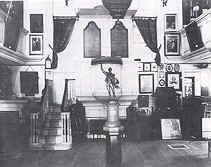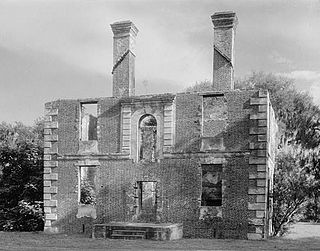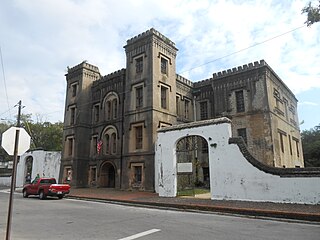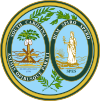Robert Mills, a South Carolina architect known for designing both the first Washington Monument, located in Baltimore, Maryland, as well as the better known monument to the first president in the nation's capital, Washington, DC. He is sometimes said to be the first native-born American to be professionally trained as an architect. Charles Bulfinch of Boston perhaps has a clearer claim to this honor.

Heritage Documentation Programs (HDP) is a division of the U.S. National Park Service (NPS) responsible for administering the Historic American Buildings Survey (HABS), Historic American Engineering Record (HAER), and Historic American Landscapes Survey (HALS). These programs were established to document historic places in the United States. Records consist of measured drawings, archival photographs, and written reports, and are archived in the Prints and Photographs Division of the Library of Congress.

Drayton Hall is an 18th-century plantation located on the Ashley River about 15 miles (24 km) northwest of Charleston, South Carolina, and directly across the Ashley River from North Charleston, west of the Ashley in the Lowcountry, sometimes called An outstanding example of Palladian architecture in North America and the only plantation house on the Ashley River to survive intact through both the Revolutionary and Civil wars, it is a National Historic Landmark.

The Historical Society of Pennsylvania is a historical society founded in 1824 and based in Philadelphia. The Society's building, designed by Addison Hutton and listed on Philadelphia's Register of Historical Places, houses some 600,000 printed items and over 19 million manuscript and graphic items. The Society maintains printed collections on Pennsylvania and regional history and manuscript collections covering 17th-, 18th- and 19th-century history. The holdings of the Balch Institute for Ethnic Studies were added in 2002 and those of the Genealogical Society of Pennsylvania in 2006. The Historical Society has recently undertaken efforts to appeal to a younger demographic, including having open bar events.

The Wisconsin Historical Society is simultaneously a state agency and a private membership organization whose purpose is to maintain, promote and spread knowledge relating to the history of North America, with an emphasis on the state of Wisconsin and the trans-Allegheny West. Founded in 1846 and chartered in 1853, it is the oldest historical society in the United States to receive continuous public funding. The society's headquarters are located in Madison, Wisconsin, on the campus of the University of Wisconsin–Madison.

The Gibbes Museum of Art, formerly known as the Gibbes Art Gallery, is an art museum in Charleston, South Carolina. Established as the Carolina Art Association in 1858, the museum moved into a new Beaux Arts building at 135 Meeting Street, in the Charleston Historic District, in 1905. The Gibbes houses a premier collection of over 10,000 works of fine art, principally American works, many with a connection to Charleston or the South.
Founded in 1869, the Historical Society of Berks County (HSBC) operates the Berks History Center as a museum and library located in Reading, Pennsylvania. The Society's mission, as described on its website, is "to focus attention on the unique local history, the vast material culture, and the diverse cultural heritage of Berks County by preserving, archiving, and promoting this material to instill in our citizens of all ages and ethnic groups an awareness of this growing treasure trove of information. This allows the HSBC to be a major cultural magnet, drawing people to our community."

The Newport Historical Society is a historical society in Newport, Rhode Island that was chartered in 1854 to collect and preserve books, manuscripts, and objects pertaining to Newport's history.

The Fireproof Building, also known as the County Records Building, is located at 100 Meeting Street, at the northwest corner of Washington Square, in Charleston, South Carolina. Completed in 1827, it was the most fire-resistant building in America at the time, and is believed to be the oldest fire-resistant building in America today.

The Southern Historical Collection is a repository of distinct archival collections at the University of North Carolina at Chapel Hill which document the culture and history of the American South. These collections are made up of unique primary materials, such as manuscripts, letters, photographs, diaries, drawings, scrapbooks, journals, oral histories, maps, ledgers, moving images, literary manuscripts, albums, and other materials.

The Paul Hamilton House, commonly referred to as the Brick House Ruins, is the ruin of a 1725 plantation house on Edisto Island, South Carolina, that burned in 1929. It was designated a National Historic Landmark in 1970 for the unusual architecture of the surviving walls, which is partly based on French Huguenot architecture of the period.

The Nicholas Gotten House is located on 2969 Court Street in Bartlett, Tennessee, United States. It houses the Bartlett Museum, a local history museum operated by the Bartlett Historical Society.

The history of Charleston, South Carolina, is one of the longest and most diverse of any community in the United States, spanning hundreds of years of physical settlement beginning in 1670 through modern times. Charleston was the leading city in the South from the colonial era to the Civil War The city grew wealthy through the export of rice and, later, sea island cotton and it was the base for many wealthy merchants and landowners.

The Old Charleston Jail is a site of historical and architectural significance in Charleston, South Carolina. Operational between 1802 and 1939, it held many notable figures, among them Denmark Vesey, Union officers during the Civil War, high-seas pirates, and Lavinia Fisher. While it has become a popular tourist destination in recent years, it remains one of the most notable historic sites in Charleston that has not been the target of a comprehensive preservation and/or renovation effort.

The Elias Vanderhorst House at 28 Chapel Street, Charleston, South Carolina, is a four-story mansion house which was built around 1835 as a home for members of the prominent Vanderhorst family of plantation owners.
Harriott Horry RutledgeRavenel was an American writer known for a handful of biographies and histories that focused on the development of South Carolina before the Civil War and were influential in shaping the work of later historians and writers.
Albert Simons, had a sixty-year career as an architect and preservationist in Charleston, South Carolina, where he is known for his preservation work and architectural design. He played a key role in the Charleston Renaissance. Simons helped to create many nationally prominent preservation functions such as the zoning ordinance for the historic district, the first such ordinance in America, with municipal austerity, and the first Board of Architectural Review. As a professor at the College of Charleston for over 20 years, he started the School of the Arts whose building is named after him and is honored yearly through the Simons Medal of Excellence.
Founded in 1916, the Columbia County Historical Society and CCHS Museum & Library collects, preserves, interprets, and presents the history, heritage, and culture of Columbia County, New York, and serves residents of all eighteen Columbia County towns and the city of Hudson.

The Northumberland County Historical Society is a Pennsylvania nonprofit organization, which was chartered on October 26, 1925 and incorporated on May 21, 1998. Its leaders, members and volunteers are dedicated to the collection, preservation and exhibition of artifacts, documents, photographs, and other items which tell the story of Northumberland County, Pennsylvania and its people.














